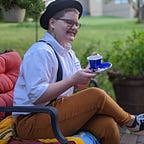Color Terminology
Published in
4 min readJun 25, 2019
This is a list of basic color theory terms and will likely be updated over time. This is intended as a frame of reference for terminology used in other articles.
A variety of terms, such as light, color spectrum, different types of color combinations (such as analogous), and others were not included in this list because they have been or will be featured in another, separate article in this publication.
Hue
- Hue is another name for color. For example, an apple’s color, or hue, may be red. The two words can be used interchangeably.
Chroma/Chromacity
- Chroma is the purity of a color. A color with high chroma has no neutral colors — white, black, or grey — added to it, and appears more vivid or pure. Adding one of those neutrals to a color reduces its chroma and the color then seems less vivid or pure.
Saturation
- How a hue looks under certain lighting. For example, a room with a yellow wall will look different throughout the day. In the morning it might look like a light yellow, while in the evening it might look gold, and at night it might look like a darker yellow or even gray.
Value
- Value is how light or dark a color is. Lighter colors have higher values — such as yellow having a higher value than a dark green. Black has the lowest value of any hue, and white the highest. This contributes to why the two colors are seen as direct opposites.
Intensity
- Intensity is the brightness/strength or weakness/dullness of a pigment. The stronger, or brighter a color is, the more pigment is present in the paint. The weaker or duller a paint color is, there’s less pigment present. This factors into nearly all art mediums and supplies.
Tones
- Tones are created when gray is added to a hue. This makes the hue look softer or more dull than before.
Mass tones
- Mass tones are different than regular tones. A mass tone is the “base” color of a color. It’s the main color you see when looking at a particular hue. For example, the mass tone of mauve is violet.
Shade
- A shade is a color created when black is added to a hue, making it a darker version of the base color.
Tint
- A tint is a color created when white is added to a hue, making it a lighter version of the base color.
Primary colors
- The three primary colors are red, yellow, and blue. These are the only colors that cannot be mixed or made from any other colors. All other colors come from these three primary colors.
Secondary colors
- The three secondary colors are orange, green, and violet. Each is made from mixing equal amounts of two different primary colors.
Complex colors
- Complex colors are colors made from mixing secondary colors. These are known in two types: tertiary and quanternary.
- A tertiary color comes from mixing two secondary colors, such as mixing green and violet.
- A quanternary color comes from mixing two tertiary colors together.
Color wheel
- The color wheel is a wheel with 12 colors surrounding it.
- The three primary colors are placed in a triad, and the rest of the colors fill in around them, as they all come from the three primary colors.
- The secondary colors fill in between the two primary colors that create them.
- The last six colors are the intermediate colors, or the tertiary color previously mentioned. These colors comes\ from mixing a primary color with an adjacent secondary color (for example, blue and violet mixing to create blue-violet). These new colors are placed between the primary and secondary color.
- All of these colors together create a 12 color wheel which can be used to visualize color matches, comparisons, as reference on how to mix different colors, and more.
Contrasting colors
- Colors opposite each other on the color wheel. For example: red and green. These two colors are contrasting, and each of them pops and is highly noticeable to the eye against the other.
Harmony
- A combination of colors that lets the eye travel smoothly between them with no sharp contrasts catching the eye. Color harmony can also refer to a color scheme — any given arrangement or combination of colors.
Undertone
- A color’s undertone is a hint of a different color present in the color. This helps to make the color a different hue than its mass tone. For example, the undertone of olive green is yellow.
